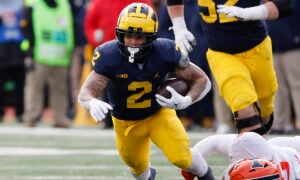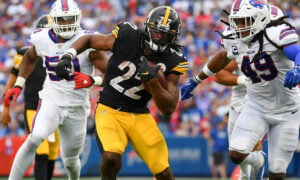Is Ageism Hurting Your Fantasy Team?
If you’re like me and you’re older than the vast majority of professional athletes, you’re probably fond of sayings like “you’re only as old as you feel” and “age is just a number”. While I fully embrace the core beliefs in those statements, I also realize that physically I’m quite a bit different from what I was 15 or 20 years ago. I’m not as fast, I don’t jump as high, and I don’t recover as quickly from an injury or illness. We’ve all seen it, so it is only natural to project those thoughts and feelings towards others when we are considering their abilities in relationship to their age.
Sure, there are always a few timeless wonders. Tom Brady looked pretty darn good for a part of the Super Bowl (let’s face it, he was pretty bad for the whole first half), and Sports Illustrated is definitely making a point with a 63 year old Christie Brinkley! But we all (hopefully!) realize that those are the exceptions and not the norm.
It is only natural for dynasty owners, concerned with not just the present but also the future, to focus in on youth and to build around it. Especially with all the attention and time we devote to the incoming rookies. We all want some new toys! But things have changed over the last few years. When I started playing dynasty leagues about a decade ago, it was explained to me that age was the tie breaker. If you have two players who are pretty close in production and ability, always go for the younger one. It made sense, but I’ve noticed over the recent years that some people have started to put a TON of weight into the age of a player. So much so that 26 and 27 year old players are now being discussed as old and being devalued. The ageism movement is in full effect, but has it gone too far and is it hurting your fantasy teams?
I don’t think any of us are fully capable of completely answering that question, especially since there is a fair amount of opinion and personal preference associated with it, but allow me to give you some things to think about.
Brief Evidence of Ageism
I’m sure I don’t need to spend a ton of time convincing people that age has become a larger part of player evaluations recently than it used to be. However, I will throw out just a few things rather quickly. Even going back less than two years ago, we see a difference. Going back to the summer of 2015, we saw three of the top five, seven of the top 10 and ten in the top 20 players by ADP who were 25 years old or older. In the summer of 2016 there were two in the top five, only four in the top 10 and nine in the top 20. Our latest ADP data has two in the top five, three in the top 10, and seven in the top 20. That’s just a snapshot at the last year and a half. Imagine if I went back five years ago!
Some might point to a few break out players in the last rookie class or two which might skew this snapshot but haven’t there always been great rookie performers? Haven’t we always seen second and third year players break out? I think the difference is instead of those young breakout players being valued as top 50 or maybe top 25 guys if they were really special, they are now being thrust into the top 10 or top 5 after just one good year. Allen Robinson, Todd Gurley, Amari Cooper, DeAndre Hopkins, Mike Evans and Odell Beckham were all top 10 if not top 5 players by ADP after just one great season. I’m not saying they aren’t great players, but the question is if they are being valued a bit higher than they should be just because of their age.
Risk of Younger Players
There are always and will always be players who don’t live up to expectations in any given year. This is most often caused by an injury, either a major one like an ACL tear or more of a nagging injury like turf toe or a groin pull. However, there are also players who get anointed a little too early in their careers or for whom the hype train just gets completely out of control. The expectations sky rocket and the player just never meets them. This is quite common for younger players. Sometimes it isn’t even their fault! They are just in a very unstable situation and it has a very negative impact on them. Guys like Robinson, Hopkins and Gurley jump to my mind right away when looking back at the 2016 season. We could find many other examples from other years as well. I think all three of these guys will end up being fine, but it wouldn’t be unheard of if one of them ends up being just average for the next few years.
Before the season started we knew that Antonio Brown and Julio Jones were going to be great as long as they stayed healthy. They had done it many seasons in a row. While they are a little bit older than the guys I mentioned a moment ago, l think the comfort level and track record of production from these guys has to count for something. One great season isn’t a pattern, yet we have a tendency to assume that as soon as a young player does it once we can count on it happening each and every year for the next half of a decade. We’ve seen time and time again that this isn’t the case. Quite often younger players have ups and downs as they figure out the league, their role on the team and as the team around them shifts. You normally don’t see that in a player who is five or six years into their career with four straight top 10 finishes at their position.
Risk of Trading Away “Old” Players
I’m sure we have all seen teams which always seem to be rebuilding. They are always shipping away their “old” players to get draft picks to improve their team, not fully realizing that the chances of the second round pick they just received out performing the player they just traded away at any point in the next few years is pretty slim. Maybe these owners just really love the process of researching players, drafting and seeing if they were right. Though most of the time I think these owners are trying to build through the draft and just taking things to a bit of an extreme.
The risk involved in this strategy really depends on what you consider to be “old”. After all, one of the things which defines the great owners from the rest are those owners who seem to be able to sell their assets at their peak value time and time again. Where I think people get themselves into some trouble is when their “sell by” age is closer to 25 than 30. The issue here is the majority of running backs and receivers hit their statistical peak somewhere around age 27 give or take a year. There are always players who peak sooner than this and a few who hit their stride later in their careers but those aren’t the norm. This means if you are selling off players at age 25 or 26, you are very likely moving them before they hit their best years! If you invested in them with a draft pick or in a previous trade, don’t you want to be able to get the most out of them from a scoring standpoint? As Herm Edwards says, you play to win the game! If you aren’t in full rebuild, you should be enjoying those prime years and selling towards the end of them not selling off your guys before they even get there!
Price vs Reward of “Old” Players
We all know about “win now” players. Those players who have limited long term value but are going to help you make a championship push this year. However, sometimes the players we label as “win now” are actually guys who might be able to help you win for the next several years. Guys like Jordy Nelson, Doug Baldwin, Larry Fitzgerald, Julian Edelman and Michael Crabtree have all been sold at discounted prices over the last several years because of their age. Yet all of them finished the season as top 20 players in PPR leagues, ahead of guys like Cooper, Hopkins and Robinson. How much the older ones have left in the tank is a matter of debate, but I don’t think anyone who bought those guys a year or two ago is complaining about the price they paid. In fact, a lot of the owners who bought those guys a year or two ago, likely at a massive discount, have been in the championship hunt the last few years.
The elephant in the room of course is how long will someone like Edelman or Fitzgerald continue to produce at their current level. Retirement is a very real possibility for any player over 30. Not only that, but they are on teams with aging quarterbacks, which could lead to potential scheme changes in the near future. They are definitely bargains now when you consider their price vs production, but how long will that be the case? Which leads me to the next part of this little editorial piece I’m writing.
How Many Years Can You Accurately Predict?
We are going to hear the following words tossed around a fair amount over the next few months, “He’s old for a rookie…” I don’t really understand that, unless they are referring to someone who is already 27. What is the real difference between a rookie who is 21 and a rookie who is 24? I know it is three years, but how many things will change by the time those three years really matter? Chances are within four or five years one or both of them will be out of the league due to injury or ineffective play. If they aren’t out of the league, they could be a backup, stuck in a terrible situation or just a very average player who you would never start on a fantasy team. This is just a microcosm of the much larger picture. How many years into the future are you actually comfortable forecasting?
I’m not talking about the difference between a 29 year old player and a 25 year old one, but if you roll it back a few years, is there really a significant difference between a 22 year old and a 26 year old? Both are likely to be productive for at least three more years if all goes well. But there is a pretty good chance that within those three years there could be injuries, they could be on a new team due to free agency, key players around them could change, coaches/schemes could change, other players could be brought in to compete at their position and any number of other things which make the NFL a very, very fluid league.
Let’s look at a quick example of this. Odell Beckham is great and has been great since his rookie year. He’s 24 years old right now. Knowing that, how many years into the future would you be willing to guarantee he is still producing at the same level? Even if we assume he stays healthy, which I believe can never be an assumption for any player, he’s going to be a free agent in two more seasons. He could end up back home in Louisiana with the Saints (who likely won’t have Drew Brees in two more years) or could go to the warm weather of Miami since he seems to like it there! Maybe the Giants do re-sign him but Eli Manning is currently 36 years old, which would make him 38 at that time. Regardless of what happens, there are an awful lot of things which could impact his status as a top fantasy receiver. Similar things could be said about almost every other player in the league.
Personally, I have a really hard time projecting players any more than three years out at the most, so that is my limit. Too many things can happen with any timeframe longer than that. So I don’t really see any difference between a 22 year old and a 25 year old. Both are young enough to produce at a high level for several more years.
Conclusion
I know some will disagree with my views, and that is perfectly okay. We all have our opinions. We all also know that age needs to be factored into dynasty player evaluations at least a little bit. Nelson and Beckham had similar seasons from a statistics standpoint, but Beckham is clearly worth much more than the soon-to-be 32 year old Packer. I’m not saying that is wrong at all. However, the question is if the value placed on age in general has gone a little bit too far to one extreme. I know before this season started (and now) I would have much, much rather owned Julio Jones than Hopkins or Robinson. It really isn’t even close. I actually preferred Dez Bryant to both of them as well.
Is the community as a whole placing too much value on age to the point where it is hurting a lot of owners? I think it is, but that also opens up an opportunity for me and you to take advantage of those who are most extreme. I make a habit of selling off young players who breakout and get hyped up to an unsustainable level. I also make a habit out of buying 26 and 27 year old players who are just about to enter their prime, but others are discounting because of their age.
Every league is a little bit different, but I would be willing to bet that you have at least one person in your league who overvalues age a bit. If you found yourself agreeing with anything I said, then pounce on the opportunity. If you are someone who tends to put a heavy emphasis on age, take a moment to ensure you aren’t valuing it too much. After all, points scored by a 32 year old count just as much as those scored by a 22 year old.
- Final 2021 Pre-Draft Rookie Mock: Round Three - April 28, 2021
- Final 2021 Pre-Draft Rookie Mock: Round Two - April 26, 2021
- Final 2021 Pre-Draft Rookie Mock: Round One - April 25, 2021


































































